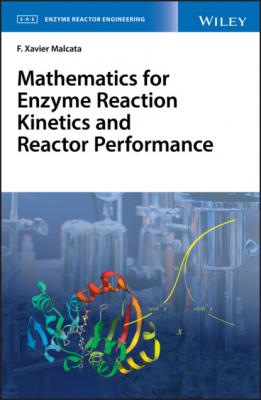Mathematics for Enzyme Reaction Kinetics and Reactor Performance. F. Xavier Malcata
Читать онлайн.| Название | Mathematics for Enzyme Reaction Kinetics and Reactor Performance |
|---|---|
| Автор произведения | F. Xavier Malcata |
| Жанр | Химия |
| Серия | |
| Издательство | Химия |
| Год выпуска | 0 |
| isbn | 9781119490333 |
by virtue of the definition of multiplication as an iterated sum.
Figure 2.2 Variation of (natural) (a) exponential, ex, and (b) logarithm, ln x, as a function of a real number, x.
The inverse of the exponential is the logarithm of the same base, i.e. ln x for the case under scrutiny encompassing e as base; the corresponding plot is labeled as Fig. 2.2b. A vertical asymptote, viz.
(2.19)
is apparent (the concept of limit will be explored in due course); the plot of ln x may be produced from that of ex in Fig. 2.2a, via the rotational procedure referred to above. In terms of properties, one finds that
– so the logarithm converts a product to a sum; in fact, Eq. (2.20) is equivalent to
(2.21)
after taking exponentials of both sides, where Eq. (2.15) supports
(2.22)
– while the definition of inverse function, applied three times, allows one to get
(2.23)
as universal condition, thus guaranteeing validity of Eq. (2.20). If n factors xi are considered, then Eq. (2.20) becomes
should x1 = x2 = ⋯ = xn = x hold, then Eq. (2.24) simplifies to
If y is replaced by 1/y in Eq. (2.20), then one eventually gets
– since ln {x/y} + ln y = ln {xy/y} = ln x as per Eq. (2.20), with isolation of ln {x/y} retrieving the above result; hence, a logarithm transforms a quotient into a difference.
The concept of logarithm extends to bases other than e, say,
a‐based exponentials may then be taken of both sides to get
– since a‐based exponential and logarithm are inverse functions of each other. If b‐based logarithms are taken of both sides, then Eq. (2.28) becomes
(2.29)
in agreement with Eq. (2.25) and after application to Eq. (2.28) – which may, in turn, be combined with Eq. (2.27) to generate
(2.30)
upon isolation of loga x, one gets
Equation (2.31) may be used to convert the logarithm of (any number) x from base b to base a – at the expense of knowledge of logb a; in particular, one finds that
when a = 10 and b = e, with ln 10 equal to 2.302 59.
The concept of base other than e may indeed be extended to the exponential function itself – and coincides with a plain power, using a as base and the target function as exponent; furthermore, one may state that
since b‐based exponential and logarithm are inverse functions of each other, and Eq. (2.25) applies; after considering an analogue of Eq. (2.18) for the power of a power, one may redo Eq. (2.33) as
In particular, Eq. (2.34)
